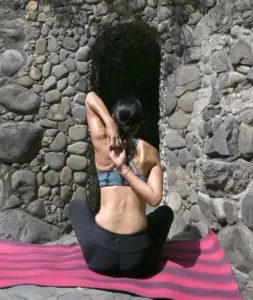The human subtle anatomy is a composite of five layers, which incorporates energy emotions thoughts intellect and intuition into a holistic relationship and in this inner playroom is where the individual explores experiences with consciousness during their course of growth and development
GoInwards Methodology | A Wellness Framework
At GoInwards, we believe that true well-being arises when we care for the entire human experience—not just the body, but also our breath, thoughts, intuition, and spirit. Our approach is grounded in a time-tested model from ancient wisdom that views the “self” as composed of five inter-connected layers. Each of these layers offers a doorway into self-understanding, healing, and transformation. Together, they form a pathway for returning home to your truest self.
Nourish · Move · Rest · Ground
This is the most tangible layer of your being—the body made of bones, muscles, organs, and skin. It’s where health begins, and where we experience the world through our senses. Caring for this layer includes eating well, moving regularly, and getting sufficient rest.
Ways to nourish this layer:
“When the body is strong and nourished, the foundation for healing is laid.”
Breathe · Awaken · Flow · Recharge
This layer includes the life force or breath that animates and energizes us. It flows through channels in the body and influences how energized, focused, or depleted we feel. When energy moves freely, we feel alive and balanced.
Ways to nourish this layer:
“The breath is the bridge between body and spirit. It carries us home.”
Reflect · Feel · Express · Regulate
This layer holds our thoughts, emotions, memories, and self-talk. It’s shaped by our inner narratives and influences how we relate to ourselves and others. When this layer is healthy, we can process emotions and respond rather than react.
Ways to nourish this layer:
“Healing begins when we allow ourselves to feel, and create space to understand.”
Discern · Understand · Align · Integrate
This layer is your inner compass—your ability to make wise decisions, to know what’s true for you, and to live with clarity. It includes insight, intuition, and the wisdom you gain from life experience and reflection.
Ways to nourish this layer:
“Your intuition is wisdom in motion. Let it guide you gently and clearly.”
Rest · Receive · Connect · Radiate
At the heart of your being is a quiet, luminous presence—a source of joy, peace, and deep connection. It has always been there. You don’t have to earn it or build it. You simply return to it. You remember.
Ways to nourish this layer:
“Joy isn’t something we chase—it’s the gentle remembering of who we truly are.”
GoInwards | The Journey Within

GoInwards is an IRS 501(c)(3) Non-Governmental Organization (NGO), chartered to advance wellness through integrative health related awareness, prevention, intervention, and resilience-based educational programs.
FEIN 90-0609802